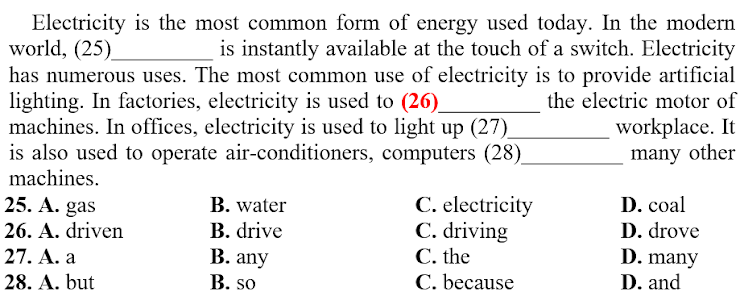Read the following passage and mark the letter A, B, C, or D on your answer sheet to indicate the correct answer to each of the following questions.
Birds have evolved many physical attributes that contribute to their flying ability. Wings are important, but adjustable tails, large hearts and light bones play critical roles.
To fly, birds, like airplanes, move air across their wings. Wings are designed so that air above the wings is forced to move faster than air below the wing. This creates higher pressure under the wings, called lift, which pushes the bird up. Different wing types evolved for different ways of flying. Prolonged flight requires long wings and an ability to soar. Other birds need superior maneuverability. Finches and sparrows
have short, broad wings. Faster birds, like hawks, have built-in spoilers that reduce turbulence while flying. This allows a steeper angle of attack without stalling.
Tails have evolved for specialized use. The tail acts like a rudder helping birds steer. Birds brake by spreading out their tails as they land. This adaptation allows them to make sudden, controlled stops-an essential skill, since most birds need to land on individual branches or on prey.
Flight takes muscle strength. If body builders has wings, they still could not flap hard enough to leave the ground. Birds have large, specialized hearts that beat much faster than the human heart and provide the necessary oxygen to the muscles. The breast muscle accounts for 15 percent of the bird’s body weight. On pigeons, it accounts for a third of their total body weight.
Birds carry no excess baggage; they have hollow feathers and hollow bones with struts inside to maintain strength, like cross beams in a bridge. Birds fly to find prey, escape predators, and attract mates-in other words, to survive
According to the passage, what causes birds to rise when they start flying?
A. Long wings with hollow feathers
B. Higher air pressure below than above the wings
C. Spreading out their tails
D. Superior muscle strength


Chọn B
Kiến thức: Đọc hiểu
Giải thích:
Theo bài đọc, điều gì giúp nâng chim lên khi chúng bắt đầu bay?
A. Cánh dài có lông rỗng
B. Áp suất không khí bên dưới cánh cao hơn bên trên
C. Việc xòe đuôi của chúng
D. Sức lực cơ bắp vượt trội
Thông tin: This creates higher pressure under the wings, called lift, which pushes the bird up.
Tạm dịch: Điều này tạo ra áp lực lớn hơn ở dưới cánh, được gọi là lực nâng, đẩy chim lên